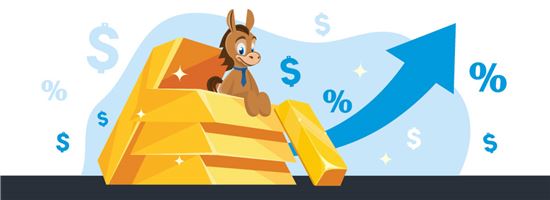Best Way to Invest Gold
Looking to invest in gold, but not sure how to go about it? Should you invest in paper or physical gold? Keep reading to learn more.
 |
- What are the best ways to invest in gold?
Some ways to invest in gold for beginners are:
There are plenty of reasons you might want to invest in gold.
Gold has been valued for much of human history. It's one of our oldest and most widely used forms of currency.
Today, gold is primarily used as a hedge against inflation. Many believe it will hold value better than their local currency.
Others use it to protect their portfolio against ups and downs in the stock market.
Since the price of gold doesn't correlate with stocks, gold is considered a "safe haven asset." Meaning its price could be high when the economy is at a low point.
But how do you go about investing in gold?
Read on to learn everything you need to know.
The Best Ways to Invest in Gold
 |
So what is the best option to invest in gold? This depends a lot on you and your investment goals.
Retirement investors might consider the benefits of investing in physical gold through a gold IRA. If you like liquidity, you can invest in gold stocks because they're easier to buy and sell.
Which is best for you? We'll go over the different options in detail so you can decide for yourself.
It generally is. Gold has high liquidity, excellent store of value, and diversifies your portfolio. But experts recommend allotting only 5% to 15% of your investment portfolio to gold.
1. Physical Gold Coins, Bars, and Bullion
First, let's cover the most obvious question: what is gold bullion?
Gold bullion is any gold that's pure, or approaching pure, that has been weighed, measured, and certified for purity.
Bullion can include coins, bars, and even the ingots you may picture when you think of gold in a bank.
When investing in these types of gold, you have plenty of options for reputable gold dealers like JM Bullion.
You can buy bars that vary by size and weight, the largest being 400 oz., sometimes known as a Good Delivery Bar.[1][2]
Coins come in dozens of varieties, from mints all over the world. Commonly traded coins include:
- Gold American Eagles
- Gold American Eagle Proofs
- Gold Canadian Maple Leafs
- South African Gold Krugerrands
- Gold Australian Striped Marlins
- Gold Austrian Philharmonics and plenty more
When buying gold coins to invest, you'll probably want to keep to more widely circulated coins. When you start trading in older or rarer coins, you will start paying for numismatic value—in other words, the value the coin holds as a collectible, beyond the simple price of the gold itself.
Yes, you can profit from investing in gold if you sell it at a higher price than you bought it for. This happens most often during economic uncertainties.
Because that's when investors typically buy more gold to hedge against inflation and preserve their wealth.
But there are some things to be aware of:
Dealers typically sell coins, bars, and bullion for between 1% - 5% above the value of the gold itself (and even as high as 10% more in the 2020s due to demand.[3] That means you'll have to pay more than spot price, and you most likely won't be able to sell for exact spot price.
And also, the larger the gold piece, the harder it is to sell. Large pieces of gold cost a lot of money, so they're less liquid. You'll likely have an easier time selling multiple coins than a single massive bar.
You'll also need a way to safely store your physical gold, whether it's in a home safe or bank safe deposit box.
Beginners can find it easier to invest in gold ETFs and mutual funds because of the overall fewer requirements and lower costs. Read on to learn more about this.
2. Gold IRAs
If you're investing in physical gold for the long term, consider doing it through a physical gold IRA. There are plenty of reputable dealers out there who will walk you through opening an account and funding it.
What is the advantage of buying gold through a gold IRA? You save money on taxes.
The IRS taxes gold as a collectible. This means you'll pay a rate of 28% for capital gains[4] if you buy and sell gold outside of an IRA.
But if you're investing in gold for retirement in an IRA, you can potentially save a lot on taxes. Gold IRAs give you the same tax advantages as regular IRAs. Your gold investment growths are either tax-deferred or tax-free.
However, gold IRAs have more fees and requirements. You'll have to pay an annual account fee and annual storage fee for storing your gold in IRS-compliant depositories
3. Gold ETFs and Mutual Funds
Next, let's look at what's known as paper gold. Paper gold investments reflect the price of gold without providing you with ownership of physical gold.
Two of the most common ways to invest indirectly in gold this way are:
- Gold ETFs
- Gold Mutual Funds
You can also trade in Gold Futures and Options, but these should be left to experienced investors who understand what they're doing and know how to minimize risk.
Investing in Gold ETFs and Mutual Funds has fewer associated costs than investing in physical gold. Therefore, they may prove to be better options for many investors.
Popular Gold ETFs and Mutual Funds include:
- The SPDR Gold Shares ETF
- VanEck Vectors Gold Miners ETF
- Franklin Templeton's Gold and Precious Metals Fund and more
Typically the expense ratios for these range around 0.61%,[5] which is less than you'll usually pay for continued ownership of physical gold.
Make sure to carefully research any mutual fund or ETF before investing in it to make sure you understand what they're offering.
4. Gold Miner Stocks
Last, one way to get exposure to the gold market without buying gold itself is through investing in the stocks of gold mining companies.
These companies' value tends to reflect the market value of gold, but ownership doesn't require buying or storing coins, bars, or bullion.
Some relevant companies include:
- Barrick Gold Corp. (GOLD)
- Newmont Corp. (NEM)
- Franco-Nevada Corp. (FNV)
Before investing in any gold miner stocks, look at the company yourself to know what you're investing in.
Yes, you can. Investing in gold has risks, especially with gold stocks and futures. So make sure you're prepared for these risks before you invest your money.
Is Gold a Good Investment?
You have plenty of options to invest your money, so why gold? Before covering all the ways to invest in gold, let's consider why you might want to do it in the first place.
Gold has value for several reasons:
- It has a limited supply. This means the more people want or need it, the more demand will go up. And so will the price.
- It's useful. Gold has uses beyond just being pretty. While plenty of people buy gold as jewelry or other collectible items, gold can be used in electronics, has applications in space, and even in dentistry and medicine.
Do you have gold in your pocket right now? Some smartphones have circuits covered in small amounts of gold because it conducts electricity well.
- It's a physical asset. Many people like gold because it is a physical asset, rather than a paper one—though you can invest in paper gold, as you'll learn below. If you want a currency that is sure to survive a technological disaster, gold may be it.
- It protects your portfolio from volatility. Gold can diversify your stock portfolio. As mentioned above, gold prices tend to move separately from the stock market. While there isn't an exact inverse relationship, there is a likelihood that when stocks are down, the gold price will surge.
All that said, it's important to keep in mind that no one can predict the future price of any asset. Plenty of people have invested in gold and lost money.
As with any investment, do your research beforehand, and never invest more money than you can afford to lose.
Physical gold (like gold IRAs and gold bullions) is best if you prefer holding onto the actual metal. But it's much harder to store and sell when needed, especially large pieces.
Paper gold, like gold ETFs and mutual funds, is better if you want something more accessible and less expensive. But market fluctuations may lower your investment's overall value.
Bottom Line
As you can see, there are plenty of excellent ways to invest in gold.
If you don't mind dealing with a degree of illiquidity, physical gold in the form of coins, bars, and other bullion is a popular choice.
You can save money on taxes by investing in a gold IRA. The companies also have dedicated customer support teams to walk you through the process.
For easier access and likely a lower introductory price, consider investing in paper gold via Gold ETFs, Gold Mutual Funds, and the stocks of gold mining companies.
There's no guarantee that gold will be a good investment in the coming years, but if you're optimistic about the shiny yellow metal, you have plenty of options.
References
- ^ United States Gold Bureau. How Much Does a Gold Bar Weigh? Gold Bar Size and Weight, Retrieved 7/25/2022
- ^ World Gold Council. Gold Facts, Retrieved 7/25/2022
- ^ MarketWatch. Opinion: 'There Is No Gold': Bullion Dealers Sell Out Amid Panic Buying, Retrieved 7/25/2022
- ^ Internal Revenue Service. Topic No. 409 Capital Gains and Losses, Retrieved 7/25/2022
- ^ ETF.com. Gold ETF Overview, Retrieved 7/25/2022
Jeremy Harshman is a creative assistant at CreditDonkey, a personal finance comparison and reviews website. Write to Jeremy Harshman at jeremy.harshman@creditdonkey.com. Follow us on Twitter and Facebook for our latest posts.
Note: This website is made possible through financial relationships with some of the products and services mentioned on this site. We may receive compensation if you shop through links in our content. You do not have to use our links, but you help support CreditDonkey if you do.
|
|
| ||||||
|
|
|













